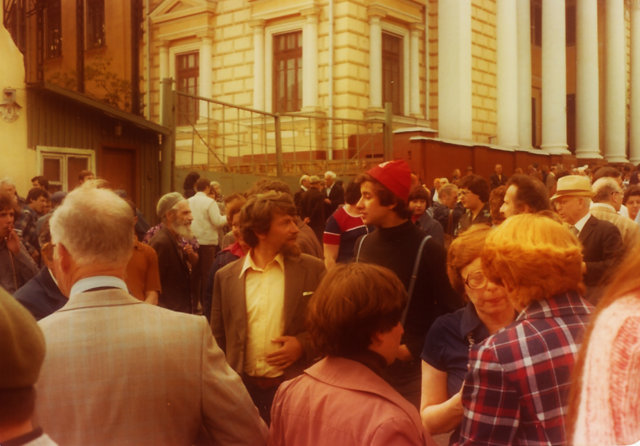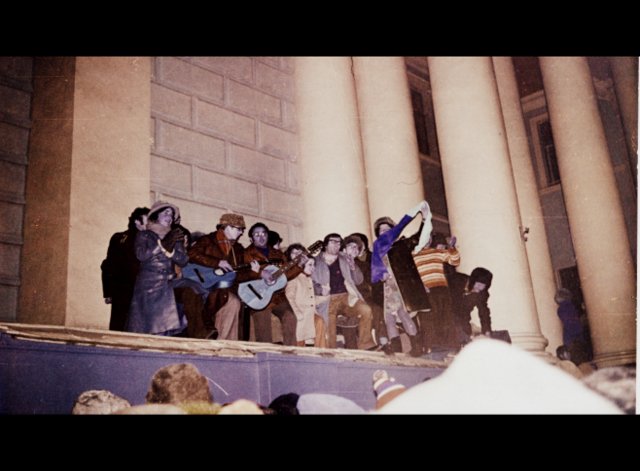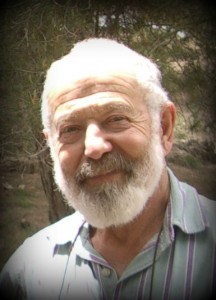In the absence of other possibilities, the Moscow refusenik community formed two outdoors “clubs.” One, the “Hill,” was located near the central synagogue on the sloping Arkhipov Street (now called Bolshoi Staroglinishchevskii Lane). The synagogue was a legitimate meeting place, which enabled a rather large number of Jews to gather near it. The youth utilized the opportunity to socialize and meet new friends─where else could they gather together? Many couples began their joint path here.
Refuseniks would come to the “Hill” every Sabbath, where they would sign letters, exchange opinions, and meet with out-of-towners and foreigners. If a visitor to Moscow had no acquaintances, he or she could go to the “Hill,” meet activists, and find out where to study Hebrew or find lodging. It was our refusenik club in the center of Moscow.
Many foreign tourists and high-ranking guests in the capital considered it their duty to visit the “Hill” on the Sabbath and see this remarkable phenomenon with their own eyes: in the very heart of a totalitarian country, hundreds of Jews would gather and discuss how to get out of the “communist paradise.” The spot was also of interest to foreign correspondents, who were frequent guests there.
We behaved properly, neither holding demonstrations or meetings near the religious site nor disturbing the public order. The regime tried to pressure the synagogue leadership, holding it responsible for the “correct” implementation of religious practice, but insofar as the Zionists gathered on the street, the leadership had few arguments to influence them.
During the periods when the “club’s” functioning was particularly undesirable or the authorities wanted to express their displeasure at some activist undertaking, police cordons would be set up at the approaches to Arkhipov Street, or a heavy stream of traffic would course down the street.
Crowds would gather on holidays, especially Simhat Torah, Rosh Hashanah, and Hanukha─tens of thousands of people of various ages and professions, including many young people. Several groups with guitars or tape recorders would sing songs in Russian and Hebrew and dance the Hora. The energy was amazing. Better than any words, this human sea bespoke the newly acquired national pride and the desire to be together and preserve one’s national identity. It was hard to find more convincing proof of the failure of the regime’s anti-Zionist and anti-Israeli propaganda directed at isolating Soviet Jewry from other Jews and forcing them to assimilate.
In an effort to stem the tide of people, the KGB officers would demonstratively photograph people from the crowd. Sometimes the authorities would partition off the street with buses or trucks and place police barricades. Nothing helped. The Jews went to the “Hill” despite the cordons, ignoring the ubiquitous tails.
One of the main organizers of the festivities during Jewish holidays was Leonid Volvovskii (b. 1942).
What led you to Zionism? I asked.[1]
The Six-Day War! It overwhelmed me and I wanted to share it with someone, but all my friends were non-Jews…and I began to seek my own people. The first time I went to a synagogue was in 1968… at Simhat Torah. I was simply carried away….
When I began to teach Hebrew, I loved to include songs in my classes as that helps to master the language. From the first lessons my students would sing “Heiveinu shalom aleihem,” or “Hinei mah tov umah naim”….
We used to organize Hanukah celebrations at my apartment, but then I thought it would be better to do it on the “Hill.” In a year or two it became part of the regular schedule at the “Hill.” Among the tourists who would come, for example, for Simhat Torah were people who knew how to sing or play some instrument; they had been specially sent. They said that they had been told to find me and to ask what to do. You can’t believe what went on there! A person would come up to me, I would place him at a certain spot, and say: “Stand here and play something.” He would play for three hours and not leave that spot. There were several such places. Our group was also there: Leva Kanevskii, Zhenia Finkelberg, Misha Tigai, Igor Gurvich, and some girls. They stood on top where the synagogue columns are. After those performances, we couldn’t speak.
The second refusenik club was located in the forest. There were many inveterate travelers [i.e., to tourist locations within the USSR] among the movement’s leaders and the refuseniks felt at home in the forest. In 1973, Aleksandr Lerner, whose apartment had long ceased to hold all those who wished to celebrate the Jewish holidays together, suggested going to the forest for Israel Independence Day. “There were a lot of people,” recalls Dina Beilina.[2] “Judith Abramovna [Lerner’s wife] prepared kebabs for everyone. It was a surrealistic scene. We ate kebabs, sang, and danced, while the hungry KGB men surrounded us.” The first meeting place, which was suggested by Aleksandr Lunts and remained constant for several years, was called the “Lunts Glade” among refuseniks.
In 1975, when the Helsinki Accords were signed, the cultural trend became more popular among Jewish activists, and the atmosphere in the refusenik community promoted the flourishing of the “forest club.”
Anatolii (Natan) Shvartsman (b. 1929), an inveterate traveler, worked until1973 inthe closed Institute of Automated Instruments in which other well-known refuseniks also worked─Grigorii Rozenshtein and Aleksandr Yoffe. He joined the refusenik community in January 1975.
From the first visit, recalls Shvartsman, I understood how inconveniently the “Lunts Glade” was located.[3] It was in the southwest part of Moscow, which was accessible only by bus, and when the KGB discovered that, at certain hours, many Jews would get on the bus near that glade, they simply instructed the bus drivers not to stop there. My wife and I preferred to stroll in several spots in the area of Ovrazhki, where there was a pine forest and wonderful air. One glade, which was a special favorite, became our constant meeting place─Ovrazhki.
As far as I recall, we gathered most frequently at that glade, and out-of-town trips became customary. Did you work out a special program?
I can’t say that initially there was a particular plan. The idea developed in the course of things. At first, we very carefully prepared the location. My wife and I went there a day earlier, on Saturday, before the general meeting, which was designated for Sunday. We spent all of Saturday in preparations. We marked beams that were suitable for seating and when people began to gather, together we dragged them to the earlier designated spots. In a suitable location we constructed something like a hut. In addition, we improvised tables on the ground, spreading out the long paper rolls that were tossed away in abundance in our new workplace. It turned out to be very cozy. People came with guitars and sang, and some people told stories.
The first meeting was on May 9, 1976. Afterwards, we used to gather every two weeks.
There were a lot of varied activities at Ovrazhki.
A lot of people would gather and we decided to invest more energy in the content of the meeting. Lenia Volvovskii dealt with lectures and speeches.
How was the program of the meetings decided? I asked Volvovskii.[4]
Generally, it was divided into two parts. The first part included a short lecture on history, culture, tradition, or a story about an approaching holiday or something about Israel, and the second part was Jewish songs. I myself would speak or I would ask someone else. Misha Nudler was a big help. Either Essas or someone else would speak. Then came the singing. There was already a good group that sang at farewell parties or holidays─Zhenia Finkelburg, Igor Gurvich, and Leva Kanevskii.
In addition there was a sports section such as soccer, volleyball, or so forth. I used to listen all the time to song contests on Israeli radio stations and saw that we had a rather large number of people who sang. I thought that we, too, could do something similar. Then Misha Nudler, Zhenia Liberman and I decided to organize a Jewish song contest. I chose to do it on Succot, when many people would come. The first contest took place in 1977 and was subsequently held every year.
As far as I recall, the song contest was conducted four times.
The last time was in 1980; I missed it because in January 1980, I was exiled to the city of Gorkii. The first contest had a simple set-up but subsequently, a technical question arose. We needed good acoustics but the KGB would play dirty tricks on us. We chose an area where hundreds of people could sit and that was near a soccer field. As soon as we chose the area, the field was immediately sown and a sign forbid passage.
During the second contest, which, as you recall, was on a Sunday, a non-working day, a tractor was brought in and a farmer was forced to plow the field. He didn’t understand anything but he was forced to do so and he plowed. It was, however, his day off, he had plowed everything well, and he wanted to leave. But the KGB men said to him: “Come on, do it again.” The farmer was simply astonished! He told us this himself. They needed him to make noise. He did it quickly for the second time and wanted to go home. Then the KGB told him to leave the tractor running, and he could go home. “How come?” the farmer said, “the tractor will soon be damaged.” They told him, “That’s not your problem; if something happens, we’ll pay.” Why did Boria Chernobylskii receive a fifteen-day sentence then? Because he went up to the tractor and silenced the motor but the KGB wrote that he attacked someone…. Nevertheless, the success was ours. In preparation for the second festival, Edik Nizhnikov and his son had brought a suitcase full of storage batteries for amplifiers. We had speaker systems and microphones. Because the tractor was relatively distant, the speakers drowned out the noise and the contest took place. They weren’t able to do a thing.
Leonid Volvovskii was expelled from Moscow in January 1980. The compass of international politics was again pointing in the direction of “Cold War,” and Leonid was too active, noticeable, and bold. In addition, in that year the authorities were “cleaning up” Moscow for the Olympics. The final song contest, for which about two thousand people gathered, was an unforgettable spectacle. Zhenia Liberman and Mark Lvovskii conducted the contest.
Our sports interests gradually led to thoughts of organizing sports competitions.
The idea arose, recalls Anatolii Shvartsman, of organizing sports events, a Maccabiah, on Lag B’omer.[5] From 1977 onward, we held it annually. We needed equipment for the Maccabiah but there wasn’t much money─after I left my work in a closed institute, my salary declined by half. I therefore bought all the equipment in second-hand shops at distressed prices. This included volleyball nets, balls, chessboards, and badminton nets, and I marked the boundaries of the play areas with string.
When did you apply for an exit visa?
In January 1975.
When did you receive it?
I stepped on Israeli soil on December 1, 1988.
Refusenik families retained lasting, positive memories of Ovrazhki and happily renewed the tradition in Israel; each year the families meet in the Ben Shemen forest. In Israel, as in Moscow, the Shvartsman family plays an active role, preparing photography exhibits and a program of speeches and informing refuseniks of the date. Everything is as it was in the old days.




